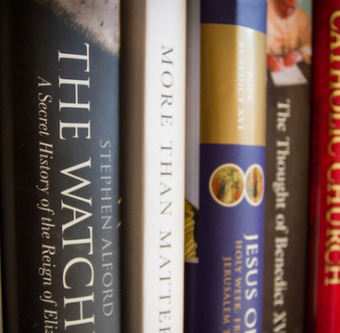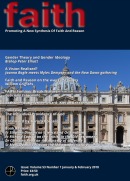
Book Review - A positive approach to suffering
Where is God in suffering? by Brendan Purcell, Veritas, 156pp, £12.99.
reviewed by Christina Read
Brendan Purcell has given us a helpful reflection on the important topic of God and suffering. It is a slim and accessible volume, taking a personal approach without eschewing theological and philosophical perspectives.
Purcell’s particular method is to “listen to the voices of suffering” (p.11). He draws upon the lived experience of those for whom acute suffering and belief in God go hand in hand, to see what light they shed on the perceived incompatibility of suffering and a good God. The suffering and death of Jesus Christ emerge as central in this treatment.
Drawing on the thinking of Pope Francis, the response to suffering is presented as “a path, something to be lived” (p.14). The common thread running through the book is “that suffering is addressed to us as persons, and that we – and those affected by it – may be somehow able to grow as persons, by the courage and love it demands” (p.16).
The wrongdoing of human beings
The first few chapters offer some general reflections on the topic, accompanied by memorable illustrations from literature (Camus, Dostoevsky, Flannery O’Connor) and from real-life experience.
Behind the rejection of God on account of suffering, Purcell often uncovers a rejection of the world as it is, its structure and physical laws, and of the nature of life on earth. He proposes a more balanced reflection on the significance for life on earth of the forces involved in disasters and on what we can do to protect and support people facing such disasters.
He also draws attention to the role of human freedom and responsibility. The order of the world has been profoundly disturbed by the wrongdoing of human beings, starting with the first human beings and going down throughout history (although the significance of the Fall could be more developed in an account of God and suffering.) Any consideration of evil must start with “a self-examination of our own capacity for the wilful undoing of ourselves and others” (p.34).
An irrevocable ‘yes’
Purcell begins his detailed consideration of witnesses to suffering (ch.4-6) with Chiara Luce Badone (1971-1990), a lively teenager with a wide circle of friends who was diagnosed with one of the most aggressive and painful forms of terminal bone cancer.
During twenty-five minutes on her own, lying face down on her bed, she made an irrevocable ‘yes’ to her situation, and from then on lived her suffering as a gift from God. She wrote to a friend: “I feel enveloped in a splendid plan which is being revealed to me little by little” (p.63). In this way, in contrast to what one might expect, this time of suffering and imminent death was simultaneously a time of light in which above all else Chiara witnessed to the gift of life.
Coherence
Her doctor, a critic of the Church who did not share Chiara’s faith, said, “Since I met Chiara something changed inside me. There’s coherence here and I can understand Christianity” (p.68). Another doctor reflected: “Through her smile, and through her eyes full of light, she showed us that death doesn’t exist; only life exists.” (p.68).
There were still times of great anguish in which Chiara felt overwhelmed by suffering, “But it’s my spouse who’s coming to visit me, right?” she wrote, and repeated: “If you want it, Jesus, I want it too.” From her union and cooperation with God she was able to offer every detail in her life for love of Jesus, desiring that “everyone may understand what an immense free gift life is and how important it is to live it in every moment in the fullness of God” (p.63).
In the Holocaust
Purcell goes on to consider the testimony of Etty Hillesum, a highly educated Dutch Jew who perished in the Nazi holocaust. Etty’s response to the evil and suffering building up around her was an unexpected development of spiritual and religious awareness. Instead of despairing she came to a deeper understanding of God and humanity; instead of blaming, she expressed a strong sense of human responsibility for the suffering she witnessed: nothing can be changed in the world until we change ourselves.
Discovering the presence of God within her, her concentration camp writings witness to the appalling misery of life there, but also to her enduring sense that “life is glorious and magnificent”(3 July 1943 cited p.88), and “that they cannot rob us of anything that matters” (11 July 1942 cited p.88) “Against every new outrage and every fresh horror, we shall put up one more piece of love and goodness, drawing strength from within ourselves” (3 July 1943 cited p.88).
‘Jesus forsaken’
Next Purcell explores the relationship between God and suffering in the book of Job and then, in the following chapter, gives more detailed treatment of the recurrent theme central to his understanding of the Christian response to suffering: Jesus’ experience on the cross.
Before her cancer diagnosis Chiara Luce Badone had been influenced by the Focolare movement and its focus on Jesus’ cry on the cross, ‘My God, my God why have you forsaken me”, as the moment in which he reunites us to God and to each other. She was inspired by the idea that loving ‘Jesus forsaken’ involves meeting and loving him in the difficulties of life. (p59) For the founder of Focolare, Chiara Lubich, this cry of Jesus on the cross had been explained as the greatest moment of Jesus’s suffering. She came to see this as a moment of genuine human doubt permitted by God the Father, in which Jesus shows the greatest love, faithfully commending his Spirit to the Father. All human suffering can then be seen as ‘with’ Jesus in this moment of forsakenness and faithful love, which brings about reunion with God. “Jesus showed the way to unity with his Father by losing the experience of that unity”. (p120) This perspective has helped Purcell and many others to live their own sufferings in a way that gives them meaning.
The human anguish of Jesus
The exact nature of a theology of abandonment on the cross could do with clarification, in view of the extreme formulations of some contemporary theologies (which introduce distance and division into the Trinity), and bearing in mind that the cry of abandonment is a quotation from Psalm 21, a psalm of trust in God. Clarity here is particularly important in a period that tends to downplay the divinity of Christ whilst modelling his humanity on our broken version, rather than the other way round. Edward Holloway frequently drew attention to the profound intensity of the human anguish of Jesus in the garden of Gethsemane, underlined in Luke’s Gospel by the sweat of blood.
Purcell has offered a profound reflection on the place of God in the midst of suffering, the illustrations from his own life and those of others giving helpful, concrete expression to the traditional identification of our sufferings with those of Christ on the cross. A positive approach to suffering becomes a reality, an extension of the basic Christian attitude of living with and for Jesus and for other people.
Notes:
Dr Christina Read studied for her doctorate at King’s College, London. She is a member of the FAITH movement and lives with her husband and children in London.





